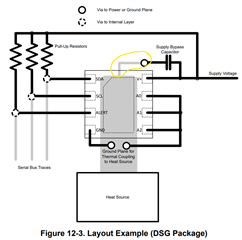Hello team,
We are using your recommended TMP1075DSGR temperature sensors to measure the temperature of our power stage (half bridge - 2kW peak - 50V nom)
To be more precise, we connect the source of the power transistor of the half bridge to the central pin of your sensor.
As shown in your datasheet.


However, we're using land polygon separation. For example, the power ground is connected to the driver winter at one point, and the driver ground is also connected to the common ground at one point, in order to eliminate the flow of power currents, which can reach 35A DC and have a significant variable component.

Your datasheet shows the connection of the heat source and probably the signal ground at one point - as shown in the figure.

We are a bit worried as to whether this connection will cause pulse noise transmission from the power ground to the digital (low-current/common) ground. Including interfering with data transmission via I2C.
However, it seems dangerous not to connect the heat source and the digital ground - will we damage the sensor in this case?
Could you please specify for us which way you consider to be the best way.
Also could you please explain how best to connect pin GND and pin A2 to the ground polygon - heat source. Thin connections as in the datasheet or it is possible to connect by polygon as shown in our layout and whether there is a fundamental difference.
Thanks and best regards,
Michael

